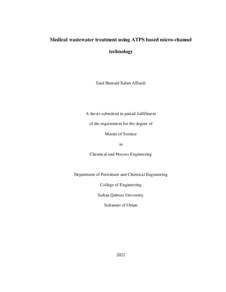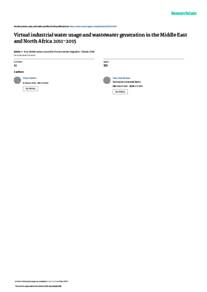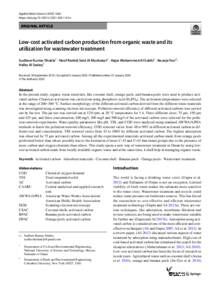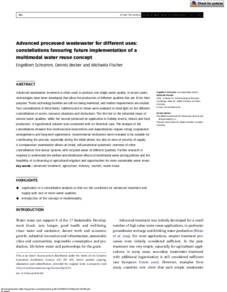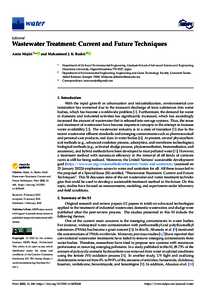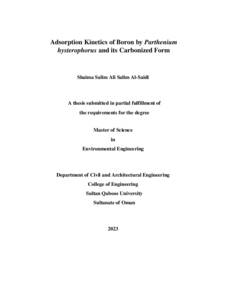Document
Medical wastewater treatment using ATPS based micro-channel technology.
Other titles
معالجة مياه الصرف الصحي الطبية باستخدام تقنية القنوات الصغيرة
Publisher
Sultan Qaboos University.
Gregorian
2022
Language
English
English abstract
Medical wastes accumulated in the environment, particularly in water, have a devastating
effect on human health and ecosystem. Antibiotics are common medical waste that
overuse may cause antibiotic resistance for humans as well as harm aquatic life. Due to
these impacts, it is necessary to find an effective way to reduce the amount of antibiotic
contaminants in the water. Many techniques are used to treat medical wastewater. The
aqueous two-phase extraction system (ATPS) is a very efficient treatment route. The
technique has high extraction efficiency, can be conducted at ambient conditions, uses a
minimal amount of solvent, and can be undertaken in a very short period especially when
conducted on a micro-channel scale. These advantages make micro-channel-based
extraction more efficient, faster, simpler, and cheaper option compared to other separation
techniques.
The work presented in this thesis aims to investigate experimentally amoxicillin removal
from wastewater using an aqueous two-phase system in conventional and micro-channel
extraction utilizing the PEG6000-K2HPO4-amoxicillin extraction system. The
experimental work was carried out in three phases: conventional extraction,
hydrodynamics analysis, and micro-channel-based extraction. The hydrodynamics study
and micro-channel extraction works were carried out in a 1 mm internal diameter and 10
cm circular glass tube. The hydrodynamics study is needed to understand the multiphase
flow behavior and select the best operational zone based on the flow patterns type and
pressure drop.
The working fluids were polyethylene glycol 6000 (PEG6000) and an aqueous solution
that consists of different dibasic potassium phosphate (K2HPO4) concentrations with 40
ppm of amoxicillin. The PEG6000 density and viscosity are 1061 kg/m3
and 0.02016
kg/m.s, respectively, while for the aqueous solution consisting of 25 wt.% salts are 1175
kg/m3
and 0.001598 kg/m.s, respectively. The range of aqueous solution and PEG6000
flow rates covered by this study were within the range of 0.01-1 mL/min. The effect of
mixing junctions and flow rates on flow patterns and pressure drop was investigated using
a high-resolution camera and a digital manometer, respectively. Four different flow
patterns were observed: drop flow, plug flow, deformed interface flow, and annular flow.
The pressure drop across the glass channel was found to increase with increasing flow
rates. Also, it was found that the flow patterns type and pressure drop were not much
affected by the inlet junction's type. For the micro-channel extraction study, a plug zone
with 0.1 mL/min of the aqueous phase and 0.1 mL/min of PEG6000 was chosen due to
less pressure drop and high mass transfer rate.
The conventional extraction experiments were conducted for 160 minutes with a mixing
speed of 500 rpm. The influence of temperature, salt concentration, and volume fraction
ratio on conventional extraction and micro-channel extraction efficiency and overall
volumetric mass transfer coefficient were also investigated. It was found that the
extraction efficiency and the overall volumetric mass transfer coefficient increase with
increasing temperature, salt concentration, and volume fraction ratio. The optimum
conditions for both conventional extraction and ATPS were found by adopting a statistical
experimental design approach. The design of experiment analysis (DoE) revealed that the
optimum process parameters, namely, temperature, salt concentration and volume fraction
ratio for the ATPS as well as the conventional extraction methods were 44.3 °C,
42.6 wt.%, and 0.5.
It was concluded that the micro-channel-based extraction method is superior for treating
medical wastewater. This is attributed to a very short contact time of 1.96 minutes as
compared to the 540 minutes needed for conventional mode. Additionally, the amount of
solvent needed to achieve target separation is much less than that consumed by the
conventional mode. The overall mass transfer coefficient achieved using the micro channel extraction (0.307727 s-1
) is much higher than the conventional extraction
(0.079985 s-1
) due to the high interfacial surface area available for contact. Such a high
interface area enhanced both extraction efficiency and solute transfer rate. Based on
process economy and efficacy, it is recommended to use micro-channel-based ATPS to
treat medical wastewater.
Member of
Resource URL
Arabic abstract
النفايات الطبية المتراكمة في البيئة وخاصة في الماء، لها تأثير كارثي على الانسان ونظامنا البيئي. تعتبر المضادات الحيوية من النفايات الطبية الشائعة والتي عند الافراط في استخدامها قد تسبب مقاومة المضادات الحيوية للإنسان وكذلك الاضرار بالحياة المائية. بسبب هذه التأثيرات، فإنه من الضروري إيجاد طريقة فعالة لتقليل كمية ملوثات المضادات الحيوية في الماء. تُستخدم العديد من التقنيات لمعالجة مياه الصرف الصحي. نظام الاستخلاص المائي على مرحلتين (ATPS (هو طريق معالجة فعال للغاية. تتميز هذه التقنية بكفاءة استخلاص عالية، ويمكن إجراؤها في ظروف محيطة، وتستخدم أقل قدر ممكن من المذيب، ويمكن إجراؤها في فترة قصيرة جدًا خاصةً عند إجرائها على مقياس قناة متناهية الصغر. تجعل هذه المميزات الاستخراج بواسطة القنوات الصغيرة أسرع، أكثر بساطة وكفاءة وأرخص من حيث القيمة مقارنة بالتقنيات الاخرى.. المقدم في هذه الرسالة إلى دراسة إزالة الاموكسيسيلين تجريبياً يهدف العمل من الماء باستخدام نظام مائي ثنائي الطور في الاستخلاص التقليدي والقنوات الدقيقة باستخدام نظام استخراج )amoxicillin4-HPO2K6000-PEG). تم تنفيذ العمل التجريبي على ثالث مراحل: الاستخلاص التقليدي، وتحليل الديناميكا المائية، والاستخراج القائم على القناة الدقيقة. أجريت دراسة الديناميكا المائية وأعمال استخلاص القناة الدقيقة بقطر داخلي 1 مم وأنبوب زجاجي دائري 10 سم. هناك حاجة إلى دراسة الديناميكا المائية لفهم سلوك التدفق متعدد الاطوار واختيار أفضل منطقة تشغيل بنا ًء على نوع أنماط التدفق وانخفاض الضغط. كانت سوائل العمل عبارة عن بولي إيثيلين جاليكول 6000 (6000PEG(، ومحلول مائي يتكون من تراكيز مختلفة من فوسفات البوتاسيوم ثنائي القاعدة (4HPO2K (مع 40 جزء في المليون من أموكسيسيلين. كثافة ولزوجة و0.02016 كجم / م.ث على التوالي بينما بالنسبة للمحلول المائي المكون من 25 3 6000PEG هي 1061 كجم / م 3 وزن. ٪ ملح 1175 كجم / م و0.001598 كجم / م.ث. معدلات تدفق6000PEG والمحلول المائي التي غطتها هذه الدراسة في حدود 1-0.01 مل / دقيقة. تمت دراسة تأثير وصالت دخول السائلين ومعدلات التدفق على أنماط التدفق وانخفاض الضغط باستخدام كاميرا عالية الدقة ومقياس ضغط رقمي. وقد لوحظت أربعة أنماط تدفق مختلفة، وهي تدفق القطرة، وتدفق السدادة، وتدفق الواجهة المشوهة، والتدفق الحلقي. وجد أن انخفاض الضغط عبر القناة الزجاجية يزداد مع زيادة معدلات التدفق. أي ًضا، وجد أن نوع أنماط التدفق وانخفاض الضغط لم يتأثروا كثي ًرا بنوع الوصالت. بالنسبة لدراسة استخراج القناة الدقيقة، تم اختيار منطقة تدفق السدادة 0.1 مل / دقيقة من الطور المائي و0.1 مل / دقيقة من 6000PEG تم اختيار هذه المنطقة بنا ًء على انخفاض الضغط ومعدل انتقال المذاب المرتفع. أجريت تجارب الاستخلاص التقليدية لمدة 160 دقيقة بسرعة خلط 500 دورة في الدقيقة. تم فحص تأثير درجة الحرارة وتركيز الملح ونسبة الكسر الحجمي على الاستخراج التقليدي وكفاءة استخلاص القنوات الدقيقة ومعامل النقل الحجمي الكلي. وجد أن كفاءة الاستخلاص ومعامل انتقال الكتلة الحجمي الكلي تزداد مع زيادة درجة الحرارة وتركيز الملح ونسبة الكسر الحجمي. تم العثور على الظروف المثلى لكل من الاستخراج التقليدي و ATPSمن خالل اعتماد نهج التصميم التجريبي الاحصائي. أظهر تصميم تحليل التجربة (DoE (أن معامالت العملية المثلى وهي: درجة الحرارة وتركيز الملح ونسبة الكسر الحجمي لـ ATPS وكذلك طريقة الاستخراج التقليدية كانت 44.3 درجة مئوية و42.6 وزن٪ و.0.5 وخلص إلى أن طريقة الاستخراج المعتمدة على القنوات الصغيرة متفوقة في معالجة مياه الصرف الصحي. يُعزى ذلك إلى وقت الاتصال القصير جدًا البالغ 1.96 دقيقة مقارنة بوقت الاتصال البالغ 540 دقيقة الالزم للوضع التقليدي. بالاضافة إلى ذلك، فإن كمية المذيب الالزمة لتحقيق الفصل المستهدف أقل بكثير من تلك التي يستهلكها الوضع s 0.307727 (أعلى بكثير من التقليدي -1 التقليدي. معامل نقل الكتلة الاجمالي الذي تم تحقيقه باستخدام القناة الدقيقة ( ) -1 s 0.079985(نظ ًرا لسطح الواجهة العالي المتاح للتلامس. أدى ذلك إلى تعزيز كل من كفاءة الاستخراج ومعدل نقل المادة المذابة. بنا ًء على اقتصاد العملية وفعاليتها. يوصى باستخدام ATPS القائم على القنوات الصغيرة لمعالجة معالجة مياه الصرف الصحي.
Category
Theses and Dissertations

